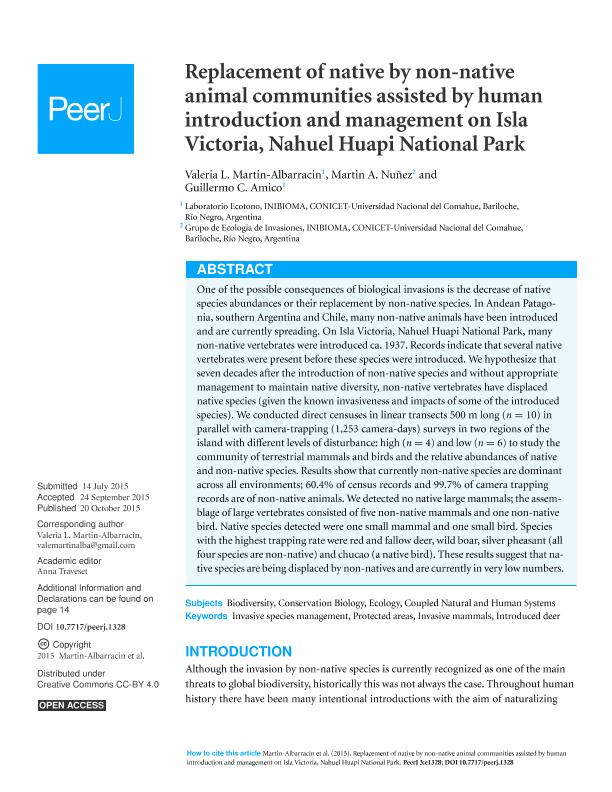Artículo
Replacement of native by non-native animal communities assisted by human introduction and management on Isla Victoria, Nahuel Huapi National Park
Fecha de publicación:
07/2015
Editorial:
PeerJ Inc.
Revista:
PeerJ
ISSN:
2167-8359
Idioma:
Inglés
Tipo de recurso:
Artículo publicado
Clasificación temática:
Resumen
One of the possible consequences of biological invasions is the decrease of native species abundances or their replacement by non-native species. In Andean Patagonia, southern Argentina and Chile, many non-native animals have been introduced and are currently spreading. On Isla Victoria, Nahuel Huapi National Park, many non-native vertebrates were introduced ca. 1937. Records indicate that several native vertebrates were present before these species were introduced. We hypothesize that seven decades after the introduction of non-native species and without appropriate management to maintain native diversity, non-native vertebrates have displaced native species (given the known invasiveness and impacts of some of the introduced species). We conducted direct censuses in linear transects 500 m long (n = 10) in parallel with camera-trapping (1,253 camera-days) surveys in two regions of the island with different levels of disturbance: high (n = 4) and low (n = 6) to study the community of terrestrial mammals and birds and the relative abundances of native and non-native species. Results show that currently non-native species are dominant across all environments; 60.4% of census records and 99.7% of camera trapping records are of non-native animals. We detected no native large mammals; the assemblage of large vertebrates consisted of five non-native mammals and one non-native bird. Native species detected were one small mammal and one small bird. Species with the highest trapping rate were red and fallow deer, wild boar, silver pheasant (all four species are non-native) and chucao (a native bird). These results suggest that native species are being displaced by non-natives and are currently in very low numbers.
Archivos asociados
Licencia
Identificadores
Colecciones
Articulos(INIBIOMA)
Articulos de INST. DE INVEST.EN BIODIVERSIDAD Y MEDIOAMBIENTE
Articulos de INST. DE INVEST.EN BIODIVERSIDAD Y MEDIOAMBIENTE
Citación
Martin Albarracin, Valeria Leticia; Nuñez, Martin Andres; Amico, Guillermo Cesar; Replacement of native by non-native animal communities assisted by human introduction and management on Isla Victoria, Nahuel Huapi National Park; PeerJ Inc.; PeerJ; 2015; 10; 7-2015; 1-19
Compartir
Altmétricas




